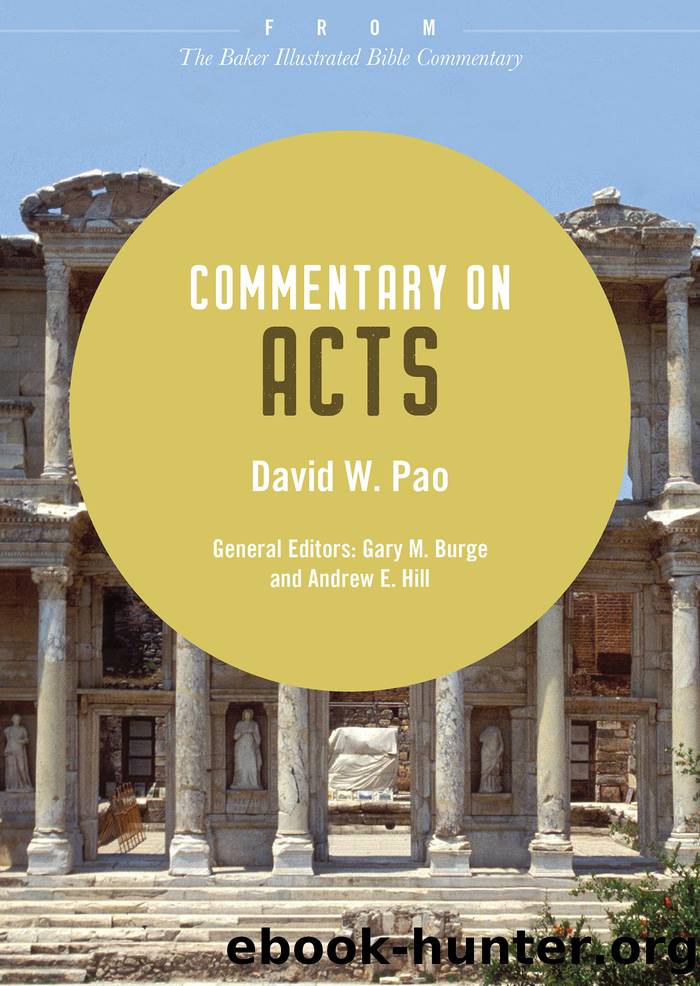Commentary on Acts by David W. Pao

Author:David W. Pao [Burge, Gary M. and Andrew E. Hill]
Language: eng
Format: epub
Tags: Bible Commentary/New Testament, REL006050, REL006070
ISBN: 9781493424672
Publisher: Baker Publishing Group
Published: 2019-10-24T00:00:00+00:00
The remains of the Basilica of St. Paul at Pisidian Antioch. Foundation stones at the southern wall of the church (left) have been dated to the first century and may be the remains of the synagogue in which Paul preached (Acts 13:14â42).
The triumph of the word is manifested when the punishment uttered by Paul is fulfilled (13:11). This punishment of loss of sight is significant because it reverses the promises of the Old Testament prophet that âall people will see Godâs salvationâ (Luke 3:6; cf. Isa. 40:5); this also counters Paulâs aim in his preaching to the Gentiles as he seeks to âopen their eyes and turn them from darkness to lightâ (Acts 26:18). The conversion of the proconsul also points to the power of the word of God as a governor of a Roman senatorial province subjects himself to the authority of the risen Lord.
The center of this account of the first missionary journey lies in Paul and Barnabasâs experience in Pisidian Antioch, of the Roman province of Galatia (13:13â52). The account begins by locating them in a synagogue (13:13). As Jesus began his public ministry with a sermon in a Jewish synagogue (Luke 4:14â31), Paul also begins his public ministry as a missionary in a synagogue. As in the case of Jesusâs Nazareth sermon, Paulâs sermon also provides a unique glimpse into his preaching in a Jewish synagogue, because although Luke mentions Paul visiting the synagogue often (14:1; 17:1â2; 18:4â5; 19:8), only here does he provide the content of his synagogue preaching.
The content of this lengthy sermon occupies much of the first part of this section (13:16â41). The first section (13:16â25) presents a review of history that connects the mighty acts of God during the exodus event to the eschatological deliverance that comes through Jesus. Paul also directly identifies Jesus as the descendant of David, whom John the Baptist testified to be the one who fulfills Godâs promises. The second section (13:26â31) focuses on the climax of salvation history: although the people of God rejected the savior promised by God, God raised Jesus from the dead. The third section (13:32â37) lists three Old Testament promises that point to the resurrection of the Son of God (13:33 [Ps. 2:7]; 13:34 [Isa. 55:3]; 13:35 [Ps. 16:10]). These quotations pick up Paulâs earlier claim as they point to Jesus as the fulfillment of the Davidic promise. Psalm 2:7 identifies Jesus, the descendant of David, as the Son of God. Isaiah 55:3 points to the faithfulness of God toward his own people as he fulfills his promises to David. Psalm 16:10 points to the resurrection as a sign for Godâs eternal blessings on his Son and his kingdom. The final section (13:38â41) calls the people of God to believe in Jesus and his gospel. This section ends with a quotation from Habakkuk 1:5, one that warns the audience not to follow their leaders in Jerusalem in rejecting Godâs mighty acts through his Son.
As in the case of Jesusâs experience in Nazareth (Luke 4:22), the Jewsâ initial response to Paulâs message is positive (13:42â43).
Download
This site does not store any files on its server. We only index and link to content provided by other sites. Please contact the content providers to delete copyright contents if any and email us, we'll remove relevant links or contents immediately.
Fangirl by Rainbow Rowell(8790)
How to Bang a Billionaire by Alexis Hall(7938)
Wonder by R. J. Palacio(7745)
The Space Between by Michelle L. Teichman(6576)
The Thirst by Nesbo Jo(6442)
Assassin’s Fate by Robin Hobb(5856)
Wiseguy by Nicholas Pileggi(5320)
The Night Circus by Erin Morgenstern(5041)
The Kite Runner by Khaled Hosseini(4954)
Paper Towns by Green John(4804)
Bittersweet (True North #1) by Sarina Bowen(4719)
Gerald's Game by Stephen King(4377)
Too Much and Not the Mood by Durga Chew-Bose(4096)
Pillow Thoughts by Courtney Peppernell(4018)
Goodbye Paradise(3452)
Twelve Days of Christmas by Debbie Macomber(3416)
Good by S. Walden(3349)
The Rosie Effect by Graeme Simsion(3210)
The Cellar by Natasha Preston(3078)
